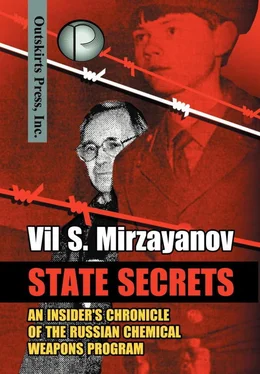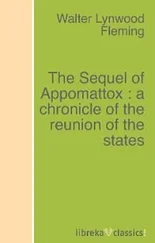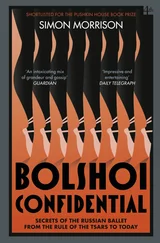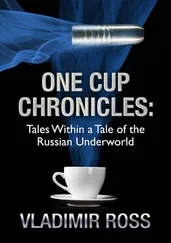In 1959, our “Post Office Box” designed a large plant for producing boranes (diborane, pentaborane, decaborane, etc.), which was built in the Redkino settlement, located halfway between the cities Klin and Tver.
Later, my boss and I visited this plant to evaluate its readiness for operation. We found significant defects in the assembly of the gas mains and the layout of equipment, which we reported to Vladimir Rostunov, the chief engineer. He was an energetic and resolute looking middle-aged man.
Twenty years later I met him again at the Novocheboksary Chemical Plant, which produced the chemical agent Substance 33, an analog to the well-known VX nerve gas. By that time, Rostunov had become the chief engineer of the Main Administration “Soyuzorgsynthesis” at the U.S.S.R. Ministry of Chemical Industry, which supervised the production of chemical weapons. He and other bosses were awarded the Lenin Prize, as well as other honors and regalia of the Soviet era, for launching the Novocheboksary Plant. He was a talented engineer and probably would have gone on to achieve more, except for his fondness of alcohol, which hindered his further career advancement.
In the early days, during my business trip to Redkino, I met many of my fellow students who had been “assigned” to this plant, where a branch of our “Post Office Box” was soon organized.
Many years later, I learned that a lot of the people who had worked there got poisoned with boranes. Some of them died, and some remained helplessly crippled for life. This happened to my fellow student, Yuri Bujnitsky. Yuri was a tall handsome man with a slightly swarthy face and a tender chin, which revealed his kindness. Apparently, this feature of his made him a little bit uncomfortable, because he was the appointed head of the workshop and had more than 200 subordinates working under him.
I met him once at the Lenin State Library in Moscow with his slim and pretty wife. I was truly happy for Yuri, and I thought that they made a beautiful couple. A few years later I found out that Yuri had been seriously poisoned. Treatments in different clinics didn’t help him, and he was completely paralyzed. His wife left him. Serendipitously, a disabled woman, who had managed to start walking, began taking care of Yuri, and a few years later he started moving a little bit.
Poisoning with boranes had terrible consequences. In addition to their immediate effect on the central nervous system, they had a strong residual effect. The product of their decomposition – water insoluble boric acid – accumulates in the blood vessels of the brain and can’t be removed.
My friends and fellow students, Yuri Ermakov and Gena Kolovertnov, who lived and worked in Redkino, were married to Hungarian girls from our group. Soon Yuri and Gena started graduate school at the Karpov Physical Chemical Institute. After graduation, they went to work in the Novosibirsk academic town with their families. Both friends were talented scientists and they made valuable contributions to the theory of catalysis. I remember when their doctoral theses were presented in GOSNIIOKhT in 1976, and the speakers referred to works of Gennady Kolovertnov. By that time, he was no longer alive. He perished in the waters of the Pacific Ocean while scuba diving. After a long flight, he put on an aqualung and dove into the water. Many people now think that long flights and alcohol consumption can lead to dehydration, increasing the chances of decompression sickness, so waiting 12-24 hours after flying before diving is commonly advised. Flying shortly after diving is even more dangerous.
Yuri Ermakov made his career in science very quickly, and he was less than 35 when he defended his doctoral dissertation and became the First Deputy Director of the Catalysis Institute of the Siberian Branch of the U.S.S.R. Academy of Sciences. Yura committed suicide. He couldn’t stand the bullying of party committees at his institute and at the Siberian Branch of the Academy of Sciences. Party members organized persecution for him, as they were not pleased that Yura had an affair with a young research assistant, whom he had unfortunately fallen in love with.
CHAPTER 5
My Chemical Career
In the autumn of 1960, I successfully passed my entrance exams and entered graduate school at the Institute of Petrochemical Synthesis at the U.S.S.R. Academy of Sciences. Still, there was a moment during my exam on the history of the Communist Party of the Soviet Union when I made a crucial mistake. There was a question about the agenda of some Bolshevik congress, and the frail docent who was examining me went out of his way to ask me leading questions, so I couldn’t remember what the Bolsheviks were talking about. Offended by my lack of diligence, this dogmatist angrily gave me a “Three” (“C” mark). I feared that a low mark in such an “important” subject would prevent me from entering graduate school, and I would have to go back to my “boranes” for one more year. However, at the institute they were rather sympathetic about my mark. Probably by that time, many people understood that the exam in Marxism-Leninism was useless for a young chemist. Still, a year later, I had to take this exam again. Before that I had to attend some insanely boring seminars at the Academy of Social Sciences, which was located opposite the “Moskva” swimming pool (where the Temple of Christ the Savior has now been built).
The first two years of my studies in graduate school were not very successful. I was sent to work in Professor Vasily Sokolov’s laboratory for the analysis and separation of hydrocarbons. The laboratory consisted of two really cramped rooms. The elderly professor was quite friendly when he welcomed me, but he didn’t suggest a topic for my dissertation research or even a workplace. However, he promised that there would surely be something when the construction of a new building at the institute was completed. This was supposed to take place two years later, but the problem was that I had only three years to study.
All I could do was to doggedly peruse the scientific literature and to try to find a research topic myself. I had already identified the major direction I wanted my research to take. It had to be connected with chromatographic analysis. At that time, this was a relatively new area of science, and it was rapidly progressing in our country thanks to Aleksander Zhukhovitsky and Nisson Turkeltaub.
I had read almost all the available scientific literature in this field, and I was forming some ideas for my future work. However, I couldn’t do anything without instruments and a work area. My scientific supervisor wasn’t at all interested in these problems. At that time, he was carefully sowing the seeds of an idea among influential circles to create a new institute called the “All-Union Research Institute of Nuclear Geophysics and Geochemistry” (VNIIYaGG). Actually, such an institute was soon founded and Sokolov became the deputy director, as he had planned.
At the second All-Russian Scientific Conference on Chromatography, I got acquainted with Turkeltaub and told him my story. He invited me to his laboratory, which had moved to VNIIYaGG from a different institute, by that time. He suggested a topic for my dissertation and promised to introduce me to Zhukhovitsky. By then, I had just barely managed to scrape together my chromatograph and I was given a working area in the new building of the Institute of Petrochemical Synthesis.
Soon I met with Zhukhovitsky and he agreed to supervise my work. Meeting and working with Zhukhovitsky and Turkeltaub made an indelible impression on me. They were truly pioneers in the science of chromatography. I remember with gratitude how generously they helped me and many other young scientists. They gave unstintingly of their time and energy.
Читать дальше












